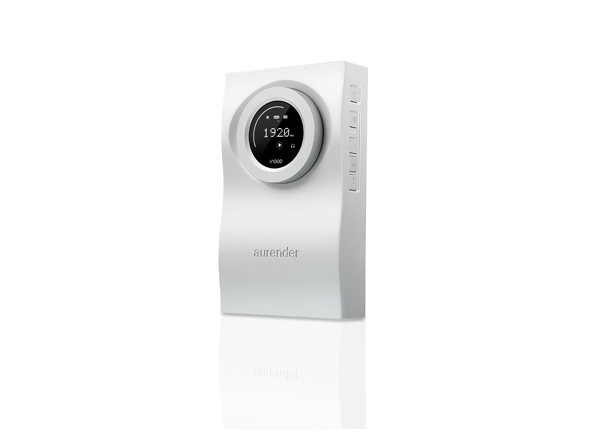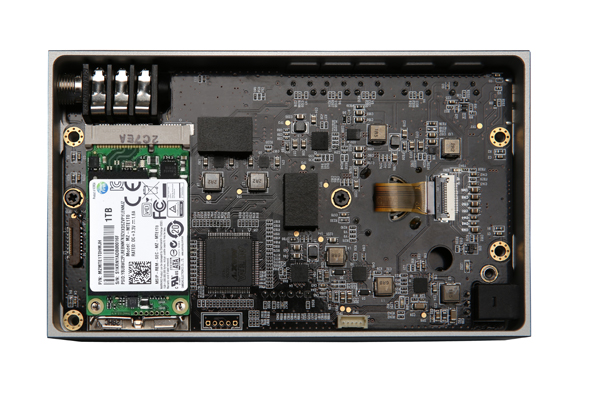Aurender Flow Headphone Amplifier and DAC
 Aurender first teased their portable DAC / headphone amplifier at the 2014 Munich High End Show. Back then it was called the “V1000” – not exactly catchy.
Aurender first teased their portable DAC / headphone amplifier at the 2014 Munich High End Show. Back then it was called the “V1000” – not exactly catchy.
Six months later at the Rocky Mountain Audio Festival in Denver, Aurender’s Sally Jeung and Harry Lee offered first listens to members of the press while also canvassing for a more promotional-friendly name. Eyeing its wavelike profile I suggested Flow – a name that Aurender would ultimately run with when bringing the device to market the following month.
Casual observers could be forgiven for thinking that the Flow is Aurender’s response to the Chord Hugo, but it’s not. Even a little hands-on time shows it to be a different beast entirely, not least because of its MSRP: at US$1295 the Flow sells for almost half the price of its UK rival.
The differences don’t end there. The Flow isn’t an in-pocket portable like the Hugo. There are no elastic straps for smartphone attachment and the rubber feet found on its base aren’t there to cushion a smartphone; they are to prevent the Flow from sliding across the desktop. Besides, the Flow’s weight (450g/15.9oz) and highly informative display screen, handsomely encircled by a velocity-sensitive volume ring, also point to desktop deployment.
The leather carrying case that ships in the box is free of cutout holes for the Flow’s digital input and quarter-inch headphone sockets, cementing its desktop assignation further. That said, it’s still a go-anywhere device – one that will readily make the to-and-fro between home and workplace.
Then there’s Flow’s most unusual feature: its internals house a slot for an optional, user-installable mSATA drive (up to 1TB). Now the music library storage burden moves from host computer to the unit itself. Don’t mistake it for a DAP though – a PC or Mac is still required to extract data from the Flow’s internal drive before the host device’s playback app feeds a datastream back to the device via the supplied USB 3.0 or USB 2.0 cable.
Usability considerations don’t end there. Along the Flow’s right side are control buttons that talk to iTunes: play/pause and playlist navigation are possible without ever needing to interface with the connected computer, iPhone or iPad. The latter find connectivity via the ubiquitous Camera Connection Kit. Android phones connect via the included OTG cable, but do check that your model supports USB audio output before putting credit card to counter. There’s no coaxial S/PDIF socket here but a Toslink input brings Astell&Kern portables, Apple TVs and some CD spinners into the picture, for which resolution is capped at 24bit/192kHz for PCM.
The Flow is backwards compatible with any USB 2.0 cable. I used a microUSB-terminated Light Harmonic Lightspeed 1G USB cable (US$99) to ensure consistency when conducting comparisons with other devices. If you don’t believe “audiophile” USB cables make a difference, that’s fine; the supplied wire won’t impede the XMOS USB and Sabre ESS9018K2M chips from handling data streams up to 32bit/384kHz PCM and DSD64/128.
Unlike the Hugo, the internal 4450mAh battery will recharge from any USB port. Off-grid listening time is pegged at around seven hours. Navigating the on-screen display via those same side-facing transport buttons allows for user selection of three charging modes (“never,” “always,” or “only when Flow is silent”) and digital filters (three for PCM and four for DSD). The way in which Aurender elegantly implements user options like this really sets it apart from much of the competition.
Now – time to listen.
I’d describe the Flow’s sound as calmly authoritative. It’s the opposite of showy. Fans of flashier micro-dynamics might find the overall presentation a little too conservative but I find its unobtrusive presentation far more conducive to all-day listening. And with so many headphones out there nowadays, especially those that already pack an abundance of transient incision, it’s easy to find an appropriate match. I didn’t have to look very far.
The Flow delivers ample go-juice to take the 600 ohm Beyerdynamic T1 to stout SPLs without surrendering acoustic mass. You can’t say that about the Resonessence Labs Concero HP. With its in-built filters, case-mounted volume control and the same ESS silicon handling decoding, the smaller, less expensive Canadian is probably the Flow’s nearest rival. However, the Concero HP sounds thinner of body and slightly ragged with the top-flight Beyerdynamic. One only has to look at each unit’s specifications sheet to see why: the Flow pushes 43mW into 600 ohms while the Concero can only muster 23mW.
Back to back with the Chord Hugo, the Flow plays it slightly cooler and a little “wetter.” A comparative lack of top-end air lends the Flow a more intimate sonic presentation than its British rival. That might be an issue for owners of the dark chocolate flavored Alpha Dogs from MrSpeakers – with which I prefer the Hugo – but it’s a win for headphones with an already well-extended top end like the Sennheiser HD800. They sound terrific here. Experience tells me this isn’t a result found with just any headphone amplifier.
It would be foolhardy to dismiss the Flow on the basis that it can’t match the Chord Hugo’s treble finesse. Its more humid air plays especially well with cans that present with more “papery” dryness. Think: AKG K-701/2 or Sennheiser Momentum.
The brushed aluminium finish that Aurender deploys across their product range makes for a terrific aesthetic match with the KEF M500 on-ears, which scale really nicely when fed with better amplification. The more considered manner in which the Flow serves up detail and layer separation plays neat counterbalance to the KEF’s sometimes more excitable manner, once again dialing down the potential for listener fatigue when tackling Genesis’s The Lamb Lies Down On Broadway or Swans’ The Seer. Office bound folk should sit up and take notice here.
Talking of which, the Flow’s infinite volume rotary makes for a wonderfully tactile experience for which one might observe favorable similarities to Devialet’s remote control. Ergonomics are often the first thing given the chop when building to a price point, but thankfully Aurender knows that inside every good audiophile is a desire to physically turn the volume up or down. Moreover, anyone who spends the day fumbling for media keys or mouse-clicking in software apps as colleagues come and go will know what I mean.
The Aurender Flow is a great way to get the very best from your favorite headphones in a tidy form factor. Its numerous considerations to the end user coupled to an elegantly powerful sonic presentation make it a delight to use on a daily basis. That it sports the most physically satisfying volume pot in its market segment only strengthens the Flow’s performance-value quotient.
-John Darko



